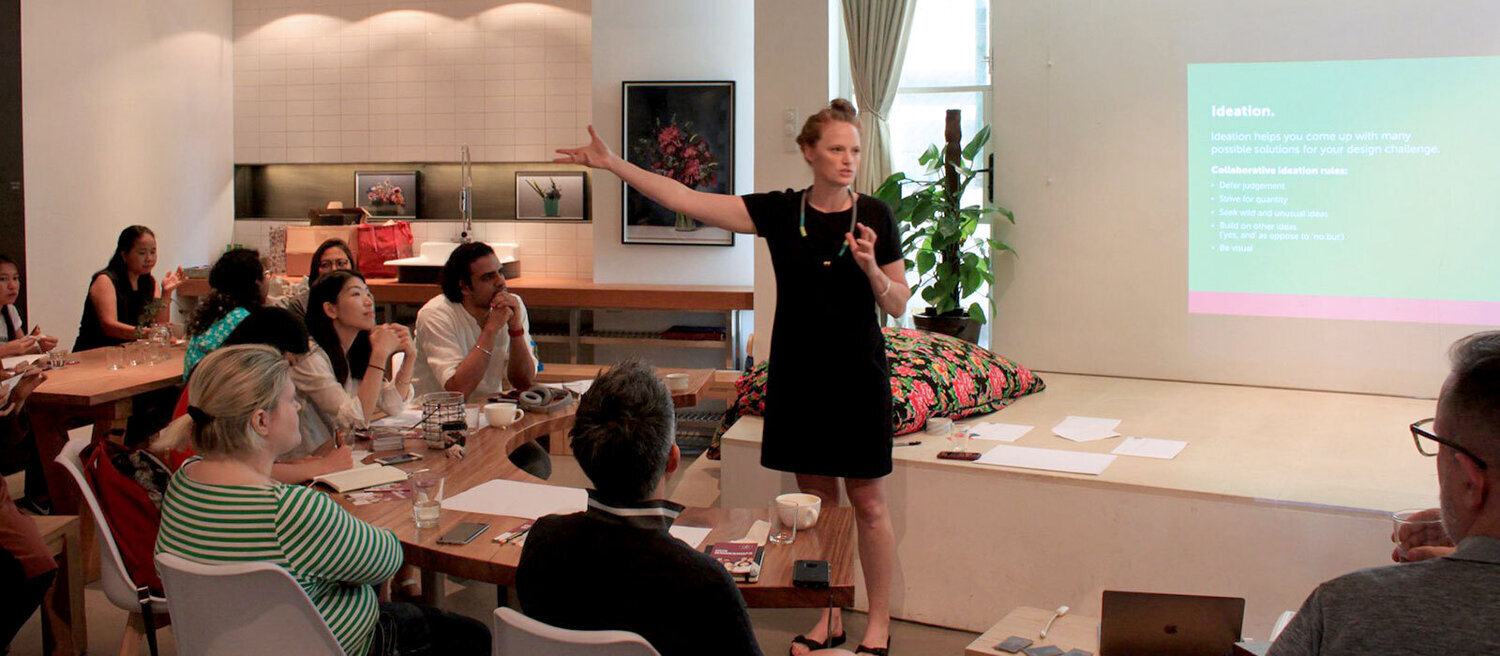ESG and the Communications Imperative: interview with Kate Okrasinski of MAKE Studios
Our series ‘ESG and the Communications Imperative’ interviews leaders across a range of industries, exploring how ESG strategies are reshaping communications, and what companies can do to maximise the impact. In our second interview, Kate Okrasinski, Director of Innovation at MAKE Studios, speaks on how design thinking and related practices can help companies take a more human-centred approach to sustainability and ESG undertakings.
1. Please tell us us a bit about MAKE Studios and your role.
MAKE is a strategic design company. We elevate and differentiate the customer experience of products, services, and brand and support our clients to attract and retain talent through employee experience.
Our methodology combines Systems Thinking with Human-centred Design and Behavioural Design to create a ‘zoom in–zoom out’ set of methods and tools. This allows us to understand our client’s services and experience within both macro and micro contexts.
With such a holistic approach, we are able to increase the quality of outcomes, build confidence in the process and bridge the gap between strategic intent and implementation.
My role is Director of Innovation.
2. How does MAKE Studios understand sustainability and in what ways does it factor into how you work with your clients?
Sustainability is a systems level capacity - where an organisation assesses their business, operations, investments and people to better understand their inefficiencies, waste and negative impact; and then uses that knowledge to refine their processes toward better, more desirable outcomes.
While there is a wealth of professionals that can help organisations to optimise the mechanics of their becoming more sustainable, the humans in the system are often the last considered or addressed - yet they are the lynchpin for success.
At MAKE, we take a human-centred stance, looking at the systems and durability required to navigate a change journey. To get an accurate view of the human systems present in an organisation, we often use the lenses of the head, hands and heart. This helps us understand the mental models, beliefs, and biases present, as well as how people feel, emotionally, both as individuals and collectively as connected to their communities and colleagues. It also give us insight into the tools an organisation has among its people, including their skills, capabilities and time.
3. From the point of view of your practice, how has the narrative about sustainability changed? What priorities are you seeing across the markets you operate in?
In our work, we are seeing teams and organisations suffer from a limited capacity for change. Whether it is a transformation, innovation or sustainability objective, many individuals cognitively understand the need for changing but are fatigued in the face of it.
Because of this, we feel the sustainability narrative hasn’t evolved to sufficiently empathise with the effort behind the ambition; nor has it enough strength to support or cater to the humans involved in the journey.
4. The vision of ESG is to provide a framework for companies to holistically transform how they understand themselves as well as how they operate day-to-day. How does design thinking relate to this vision?
Design Thinking is a powerful framework to move any complex challenge forward, sustainability-related or otherwise. In its most simple form, Design Thinking is the process of moving from data (qualitative and quantitate) to insight, where we put meaning to the data making it thick, descriptive and informative. With insight, we move to ideation where we push ourselves to explore multiple possibilities for action.
Then, through reflection and synthesis, we understand the patterns in our idea generation as a method to better understand the next best action. Through action, we generate more data, and the process starts again.
When we take this view of Design Thinking, we can immediately see that it is not a project, but a continuous, reflective capability. It is through this way of thinking and acting that our clients are able to navigate ambiguity, reduce risk and mobilise their organisations to cope with change.
5. COVID-19 has revealed the fragility of our systems and many see sustainability as a way of recovering with more resilience. Do you agree? Where does design thinking fit into the future of how we build and operate businesses?
We agree entirely.
The fragility of our systems (and people!) are the most critical concern of our clients. Design Thinking and the related practices of Behavioural Design and Systemic Design give us the tools we need to observe and map our worlds from a shared perspective - allowing everyone to see the interdependencies and demands.
Then, through the iterative practice of action and reflection we are better able to reduce the risks associated with change and identify any unanticipated needs. The goal is to actively reduce and manage risk without halting progress.
6. What is the role of communications in design thinking? What lessons could be drawn for companies looking to transform their operations to be more sustainable?
Communication is the glue that holds any amount of coordinated action or effort together. Anchoring on an individual story and need allows organisational narratives to resonate across functions and stakeholders. This requires that we understand the employee value proposition, the latent tensions and the aspirations of everyone on the floor; and, most importantly, that we invite that reality into the story.
Change is hard, it isn’t easy - but when the values and rewards are aligned, people are connected and willing. Being honest about the work and looking for shared value in the ambition (not just what it will bring to the organisation, but to its people) gives people the grit they need to adapt, evolve and take bold new steps forward.

